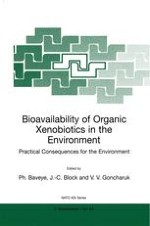1999 | OriginalPaper | Chapter
Phase Distributions of Hydrophobic Chemicals in the Aquatic Environment
Existing Partitioning Models are Unable to Predict the Dissolved Component in Several Common Situations
Authors : Örjan Gustafsson, Philip M. Gschwend
Published in: Bioavailability of Organic Xenobiotics in the Environment
Publisher: Springer Netherlands
Included in: Professional Book Archive
Activate our intelligent search to find suitable subject content or patents.
Select sections of text to find matching patents with Artificial Intelligence. powered by
Select sections of text to find additional relevant content using AI-assisted search. powered by
At present, most predictors of the truly dissolved - directly bioavailable - aqueous fraction of xenobiotic chemicals are based on predicting the attenuation from total to dissolved concentrations using models of equilibrium partitioning with bulk organic matter. While certainly a wonderfully practical and, at least in laboratory systems, often successful approach. such organic-carbon normalizing partitioning models (e.g., ref. 1, 2) are frequently not able to explain field-observed in situ phase-distributions. In this overview, we will discuss situations where the bioavailable aqueous fractions may deviate from predictions of existing speciation models: (a) strong interactions with soot result in lower dissolved exposure, (b) poor interactions with bulk organic colloids result in higher dissolved exposure, and (c) nonequilibrium interactions in systems where the solid phases are dominated by living cells may result in either lower or higher dissolved fractions. Another apparently aberrant partitioning case to be discussed is the elevated fog-drop associations of hydrophobic chemicals, in excess of their Henry’s Law expectations, which may be explained by partitioning to the interface between air and water.
